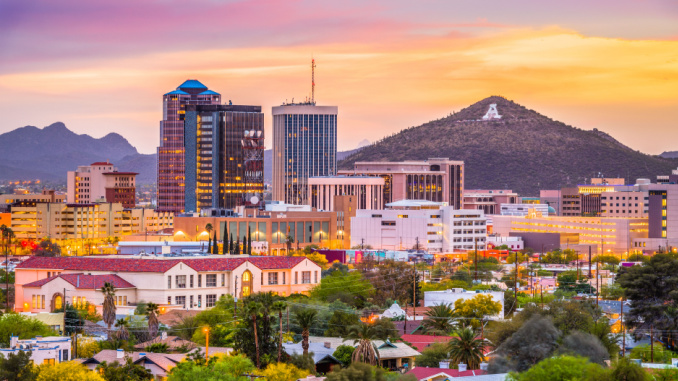
by Jonathan Eberle | Aug 9, 2025 | News
By Jonathan Eberle |
Arizona Public Service (APS), the state’s largest electric utility, announced Wednesday it will no longer pursue its previous pledge to achieve zero carbon emissions by 2050. The company also scrapped its interim emission reduction targets and removed a commitment to end coal-fired generation by 2031 from its website. The utility now aims to be “carbon neutral” by 2050 — a less stringent target that allows for continued fossil fuel use if emissions are offset through technology such as carbon capture.
“Our aspiration has evolved based on changes to energy markets and customer needs, and our plans are built around doing what’s right for the people and prosperity of Arizona,” said APS spokeswoman Jill Hanks in a statement to 12News.
The announcement quickly drew sharp criticism from environmental advocates, who accused the company of backing away from its public commitments. “APS is walking away from every clean energy promise it made to the public, to regulators, to shareholders, and to the communities it serves,” said Autumn Johnson, Executive Director of the Arizona Solar Energy Industries Association. “We are left with vague intentions and zero accountability.”
A free-market advocacy group also voiced concerns, though from a different perspective. The Arizona Free Enterprise Club argued that the new plan still comes with a heavy cost to consumers. “While this is modestly better than the carbon-free plan they have been pushing for the last five years, APS’ new ‘carbon neutral’ plan will still cost ratepayers billions,” said Scot Mussi, the group’s president. “The priority should be reliable and affordable baseload power for Arizonans, not meeting arbitrary carbon goals that require massive amounts of expensive wind and solar that will degrade the grid.”
Some of Arizona’s elected officials also weighed in. Arizona Governor Katie Hobbs criticized the decision on X, writing, “Arizona needs an abundance of energy, with a strong, and reliable grid to keep our communities safe and to continue our economic growth. This decision sets us back. It makes our air dirtier, hurts our growing clean energy economy, and forfeits the cost savings of renewable options.”
She continued, “I’ll be reaching out to APS to discuss their decision and reiterate that we must continue investing in new energy technologies and diversify our energy portfolio at the fastest rate possible.”
Hobbs’ response is interesting given her history with APS. After her inauguration, it was revealed that Pinnacle West Capital Corp., the owner of APS, donated $250,000 to Hobbs’ inaugural fund. The group also made a $100,000 donation in 2024 to Hobbs’ secret litigation fund.
Republican gubernatorial candidate, and sitting U.S. Representative, Andy Biggs offered a sharply different take than Hobbs, posting, “Every utility in our state should be prioritizing reliable and affordable energy for Arizonans, not trying to meet the demands of environmentalists pushing the Green New Scam that hurts Arizona businesses and families. As Governor, I’ll make sure Arizona aligns with President Trump’s energy agenda to help our economy flourish.”
APS data shows most of the state’s surging energy demand is coming from the expansion of data centers rather than residential growth. The company and its investors view the sector as a major opportunity for revenue.
While APS maintains it remains committed to expanding cost-competitive clean energy, the rollback represents a significant departure from the 2020 pledge.
Jonathan Eberle is a reporter for AZ Free News. You can send him news tips using this link.

by Matthew Holloway | Aug 9, 2025 | News
By Matthew Holloway |
Democrat-Socialist endorsed politicians are not only present on Arizona ballots but appear to be thriving in the Tucson Democratic Primary. Miranda Schubert, running in the Aug. 5 primary for the Tucson Ward 6 council seat, and Sadie Shaw, running against incumbent City Councilmember Kevin Dahl in Ward 3, who also sits on the Tucson Unified School District governing board, were both endorsed by the Democratic Socialists of America’s Tucson chapter.
In a statement, the Tucson Democratic Socialists of America (DSA) celebrated the early results, saying, “Tonight, Tucson rejected the status quo and supported champions for Public Power and the working class. At a time when big corporations like Amazon are threatening Tucson’s water and a liveable climate, @mirandaforward6tucson’s decisive victory and @sadieforward3 running neck and neck with a well-funded incumbent proves that Tucsonans want elected leaders who will fight for policies like free-transit, affordable housing and public power that will address the crises we are facing and directly benefit the working class people of Tucson. We look forward to working with these two socialists and the most progressive city council in recent history to improve the lives of all people in Tucson.”
According to the DSA, “The Democratic Socialists of America is the largest socialist organization in the United States because we’re a member-driven mass organization.”
The unofficial election results showed that Schubert is trending to capture the Ward 6 council seat “by a wide margin.” As of Friday evening, the tally stood at 6,343 votes, against Democrats Leighton Rockafellow Jr., with 2,927 votes, and James Sinex won 365 votes. She is expected to face Republican Jay Tolkoff, who ran unopposed in his primary. Per AZCentral, Rockafellow has conceded the race.
Schubert declared victory and thanked her supporters Wednesday night, telling them, “I love local politics because it’s so simple. It comes down to having conversations, having conversations with your neighbors and with your fellow community members, and so I hope that this can be the start of more conversations and more work to come together to make Tucson a better place for future generations.”
The Ward 6 seat was vacated by former Councilman Steve Kozachik, who handily defeated Schubert by nearly 18 points in the 2021 Democratic Primary. Kozachik later stepped down to take over the Pima Animal Care Center in 2024. He was succeeded temporarily by Karin Uhlich, who later ran in her own right to finish out his term. However, in July, Uhlich announced she would not seek reelection, leaving Schubert as the frontrunner.
In the Ward 3 race, DSA-endorsee Sadie Shaw is trailing Democrat incumbent Councilman Kevin Dahl by just 19 votes as of this report. The councilman claimed victory, but Shaw has announced that she will await the final results once they have been canvassed and certified per Arizona law. The winner will face Republican Janet “JL” Wittenbraker, who ran unopposed in her primary.
Wittenbraker recently made waves in the city election by calling out the Tucson Sentinel for “failure to interview Republican candidates on key issues such as fare-free transit, Project Blue, and TPD funding,” adding this is “emblematic of their bias,” and “very disappointing.”
In a statement following the results, she told the outlet, “Tucson is ready for change, especially in Ward 3, where poverty, homelessness, and high crime rates resulted in a competitive race between Shaw and Dahl.”
Matthew Holloway is a senior reporter for AZ Free News. Follow him on X for his latest stories, or email tips to Matthew@azfreenews.com.

by Jason Bedrick | Aug 8, 2025 | Opinion
By Jason Bedrick & Matthew Ladner |
Every year, a horde of school district officials and their lobbyists come before the state legislature, rattling their tin cups, begging for more money for their supposedly underfunded schools. They tell sob stories about crumbling buildings and underpaid teachers who had to pay for school supplies from their own pockets. Their schools, they say, are financially starved.
Hogwash.
School bureaucrats don’t want you to know it, but school spending is at an all-time high, and Arizona’s school districts are sitting on more than $20 billion in cash reserves and buildings they don’t need while student achievement craters. A new report from the Common Sense Institute (CSI) reveals the shocking scope of waste plaguing our traditional public school system, and it’s time taxpayers demanded answers.
The numbers are staggering. As has been documented, Arizona’s school districts are already hoarding $7.8 billion in cash reserves, up $1 billion since the prior fiscal year. Now we learn they’re also sitting on $12.2 billion worth of excess real estate—78 million square feet of unused and underutilized space that could house 630,000 additional students. Combined, that’s over $20 billion in resources that could be put to better use serving Arizona’s children.
Since 2019, district school enrollment has declined 5% statewide, yet these same districts increased their building space by 3% and boosted capital spending by a jaw-dropping 67% to $8.9 billion. As CSI has documented, districts have added 499 new buildings while losing 47,500 students. This isn’t just inefficient, it’s fiscally reckless.
The massive spending on new buildings might be justifiable if schools were overcrowded or expecting a huge influx of new students, but they’re not. In fact, Arizona’s district schools are already significantly overbuilt, operating at just 67% capacity while charter schools run at 95% capacity and private schools at 75%. CSI estimates that the excess space in district schools could accommodate 630,000 additional students—nearly half the current statewide district school enrollment.
The excess capacity comes at an enormous cost. CSI estimates that the market value of excess district space alone—$12.2 billion—could fund a decade of capital expenditures. Alternatively, eliminating maintenance costs for unused space would save taxpayers $1 billion annually. That’s real money that could reduce taxes, improve education, or address Arizona’s other pressing needs.
There are plenty of willing buyers. Indeed, the fastest-growing school systems—charters and private schools chosen by increasing numbers of Arizona families—struggle to find adequate facilities. Yet school districts often go to incredible lengths to avoid selling buildings to them, such as when Tucson Unified School District sold an unused building for 25% less than what a Christian school had offered, just so that a “competitor” wouldn’t have it.
In response to such cases, Gov. Doug Ducey signed a law requiring school districts to sell buildings to the highest bidder, even if it’s a private or charter school. Now, rather than comply, school districts are just letting their underutilized space languish and forcing the taxpayers to pay the bill.
The wastefulness is also a slap in the face to teachers and students alike.
As we noted previously, the districts have enough cash reserves to raise the average teacher pay from $64,420 to more than $80,000 for 10 years and still have funds left over. If they sold off all their underutilized space, they could raise the average teacher pay to $100,000 for a decade and still have billions left over.
There is no evidence that spending on buildings is contributing to student learning. As the buildings have gone up, math scores have gone down, plummeting 25% since 2019. As CSI documents, the lowest-performing schools have the most excess space, operating at just 19% capacity, while high-performing schools run at 70% capacity.
This isn’t about helping kids learn; it’s about protecting a bloated bureaucracy that puts institutional self-interest above student needs.
Fixing the problem will require realigning incentives. CSI recommends more transparency—including a “Facilities Condition Index” that would give policymakers and the public objective information about the quality of existing school facilities—and more state oversight of severely underutilized facilities. In the meantime, any funding requests from the school districts should be greeted by state lawmakers with a healthy dose of skepticism.
Arizona’s children deserve better than a $20 billion monument to government inefficiency. They deserve a system that puts their education first, not one that hoards resources while performance plummets. If local officials can’t or won’t deliver, then state lawmakers will have to step in.
Jason Bedrick is a Research Fellow and Matthew Ladner is a Senior Advisor for education policy implementation at the Heritage Foundation’s Center for Education Policy.

by Matthew Holloway | Aug 8, 2025 | Education, News
By Matthew Holloway |
In a post to X earlier this week, Chaya Raichik’s ‘Libs of TikTok’ revealed a now-deleted video allegedly created by an educator at the PPEP TEC High School’s Cesar Chavez Learning Center in San Luis, Arizona. The video urged teachers to “teach as hard as you can[.] So your students don’t grow up to be… Trump supporters.”
In a screenshot of the post, a man believed to be PPEP TEC High School teacher Edson Delgado, posting under the now-deleted profile ‘mrfacts5x’ wrote, in full, “This school year… Teach as hard as you can[.] So your students don’t grow up to be… Trump supporters. Make America Smart Again.”
In the caption of the post, he added, “If we don’t teach them critical thinking… someone else will teach them conspiracy theories. Let’s make America smart again.”
Libs of TikTok commented on the post, “Teacher at PPEP Cesar Chavez Learning Center in AZ wants to ‘teach’ students so they don’t grow up to be Trump supporters. Any comment @ppeptechs?? Do you condone teachers indoctrinating kids???”
The individual depicted in the post as ‘mrfacts5x’ bears a notable resemblance to Delgado, an educator who was honored by the office of Yuma County Superintendent Tom Hurt as doing “Great things at PPEP Tech!” In a March 25th post to Facebook and is identifiable through the certifications shown hanging behind him in the post to TikTok.
Several commenters on social media expressed reactions, ranging from concern to outrage. Political commentator Paul Szypula wrote, “Our schools are compromised.”
Columnist Emilia Henderson replied on X, “That teacher is PROGRAMMING kids with hatred for their own country. If PPEP allows this, they’re no school at all.. they’re a political FACTORY pushing Democrat obedience.”
Some critics of the TikTok post called for federal funding for PPEP TEC High School to be terminated, while others called for the teacher’s termination. At least one Arizona commenter, ‘JustADudeAZ,’ stated that he reported the incident to Arizona Superintendent of Public Instruction Tom Horne. He wrote, “Credit to Tom Horne for listening and getting back to me. He provided where to go to keep people like this teacher honest. If you see teaching like this you can report them directly using this site,” and provided a link to the Empower Hotline.
The hotline is “the forum to report about inappropriate lessons that detract from teaching academic standards such as those that focus on race or ethnicity, rather than individuals and merit, promoting gender ideology, social emotional learning, or inappropriate sexual content,” according to the Arizona Department of Education.
AZ Free News has reached out to PPEP TEC High School for comment but received no response by the filing of this article.
Matthew Holloway is a senior reporter for AZ Free News. Follow him on X for his latest stories, or email tips to Matthew@azfreenews.com.

by Jonathan Eberle | Aug 8, 2025 | Education, News
By Jonathan Eberle |
As schools across Arizona reopen for the fall semester, State Superintendent of Public Instruction Tom Horne is encouraging parents to be alert to classroom content they believe may conflict with their family’s values. His call follows a recent U.S. Supreme Court ruling affirming parents’ rights to withdraw their children from classes that conflict with their religious beliefs.
“The U.S. Supreme Court recently ruled that parents have the Constitutionally protected right to opt their children out of classes when their religious beliefs conflict with course material,” Horne said in a public statement. “As the new school year begins, I am urging parents to be aware they have the power to ensure their child’s school is concentrating on academics, not social indoctrination.”
Horne cited a case from earlier this year involving a Tucson-area teacher whose lessons, he claimed, undermined students’ religious beliefs and promoted gender ideology. According to Horne, the teacher has since retired, and the matter was resolved. “This is exactly the type of situation that was addressed in this recent Supreme Court decision,” he said.
To address concerns like these, the Arizona Department of Education operates an “Empower Hotline,” which allows parents, educators, and citizens to report what they view as inappropriate content in the classroom. Horne said the hotline has received complaints about lessons that focus on race, gender identity, or content perceived as deviating from traditional academic instruction.
“Students need education in reading, writing, math, science, history, and the arts,” Horne added. “The inappropriate lessons about which parents are complaining are a distraction from these crucial academic subjects. My principal goal has been to bring back academic focus into the classrooms.”
The Supreme Court decision referenced by Horne affirms long-standing interpretations of parental rights in education but has gained renewed attention amid ongoing debates over curriculum content in public schools across the country.
Jonathan Eberle is a reporter for AZ Free News. You can send him news tips using this link.





